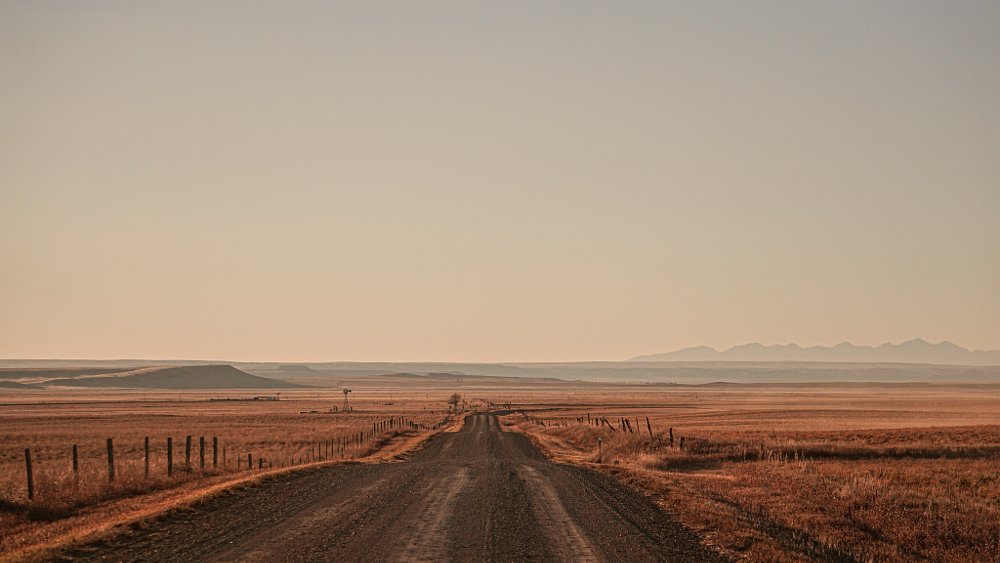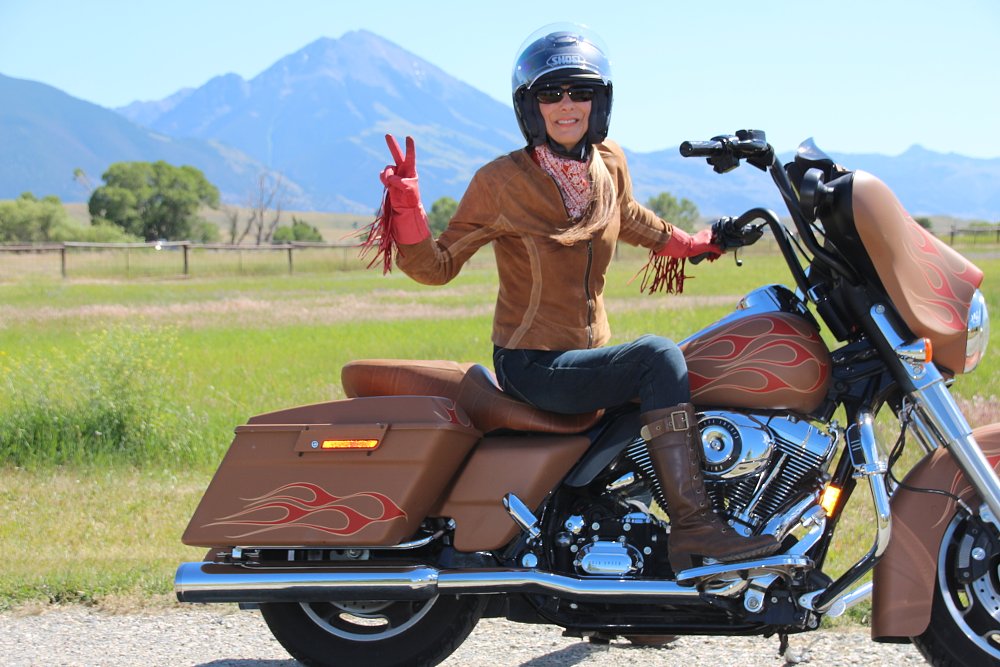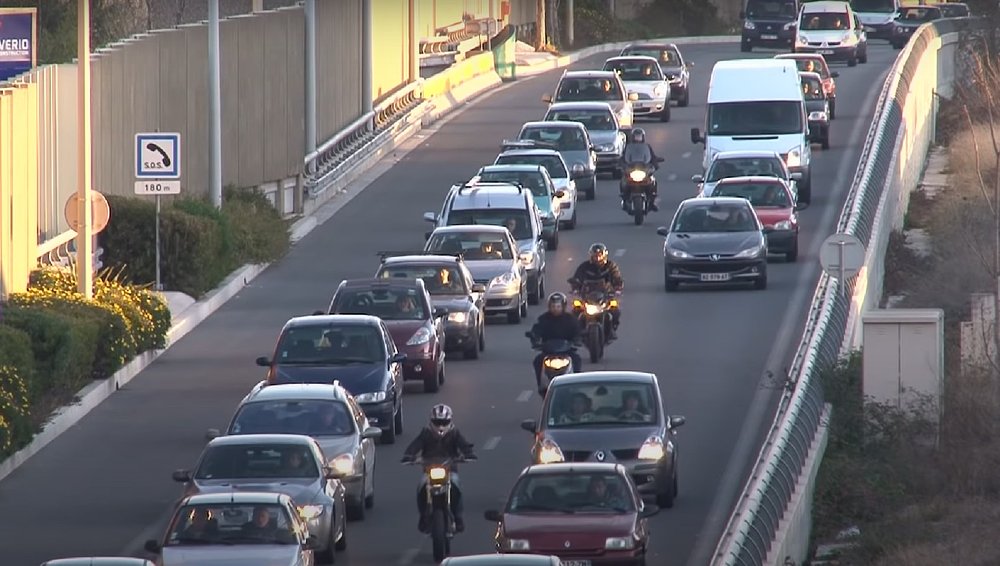Perhaps the only thing slower than gridlock is the spread of legalized lane sharing in the United States. That makes Montana’s new lane filtering bill, just a single page long, one of the biggest advancements in lane sharing since Utah passed their own filtering bill in 2018.
The distinction we're making between filtering and lane splitting is the speed of traffic. Motorcyclists can only filter between lanes while ambient traffic is moving at certain speeds or slower, and there may also be restrictions on the speed delta between filtering riders and other motorists.
Senate Bill 9 (SB9) defines filtering as “the act of overtaking and passing another vehicle that is stopped or traveling at a speed not in excess of 10 miles an hour in the same direction of travel and in the same lane.” Total speed can’t exceed 20 mph, there must be adequate passing space available, and conditions must “permit continued reasonable and prudent operation of the motorcycle while lane filtering.” It’s a fairly watered-down solution compared to what you might see in California, but it should provide some relief from the heaviest traffic. Lane filtering in Montana starts on October 1 of this year.
In comparison, Utah allows riders to filter through stopped traffic at up to 45 mph, so long as there are multiple lanes. Bills proposed in other states have similar guidelines, though none have attracted enough support to get anywhere.
You might not associate Montana with gridlock, but the new bill affects a relatively large number of riders. Big Sky Country has one of the highest numbers of motorcycle registrations in the United States, just behind Texas and Pennsylvania.)
For a local’s perspective on the new bill, I spoke with Genevieve Schmitt, veteran motorcycle journalist, longtime Montana motorcyclist, and founder of WomenRidersNow.com. (Don’t miss Spurgeon’s interview with Genevieve in a previous Common Tread article.)
Andy Greaser: I’m sure you had some experience with lane splitting when you lived in California. How long have you been a Montana rider?
Genevieve Schmitt: I moved to Livingston, Montana, in 2004, after I learned of the area while I was on an assignment working as a producer for the TV show Extra and living in Los Angeles. Part of what drew me to this area as my forever home was the spectacular motorcycle riding roads and the incredible mountain scenery. The famous Beartooth Pass is actually a day ride for me, a 400-mile loop that’s a dream excursion for so many motorcyclists traveling to this area. I feel very blessed that I can call this beautiful area to ride my home. It never gets old.
AG: I don't think most people imagine a whole lot of gridlock in Montana. What will be some impacts of lane filtering in your state?
GS: I think that once motorcyclists are aware of SB9, they’ll embrace it. It's not like we have a lot of gridlock, as you said, but certainly our urban areas are much like many other urban areas. Plenty of traffic lights, delivery trucks getting in your way... Filtering up to the front of the line at the traffic light would be welcomed. You know where it's going to be particularly good? We do have a fair amount of construction out here. The highways take a beating from the heavy winters. There's always road construction; they literally take it down to the dirt.
While waiting for construction, we motorcyclists can buzz off to the front of the line for safety, number one. And number two starting from the front gives us a sense of comfort so we can navigate, say, freshly poured gravel at our own pace. No more rocks being kicked up towards you. Another benefit will be in parks and other places motorcyclists come to ride and visit, like Glacier National Park. Riders can move ahead of slower or stopped vehicles and enjoy.
AG: Hopefully improving the ride for a lot of motorcyclists without inconveniencing any of the drivers who are going to be in that conga line anyway. What needs to happen for this to work, practically speaking?
GS: It’s going to be about educating the public on this new law because I think drivers will be startled the first time they see a motorcyclist lane splitting and say, “Wait! Why is this rider being crazy and riding between lanes?” Hopefully, the motorist will eventually figure out that this move is legal. In the end, I think motorcyclists riding to the front of the pack, say at a traffic light, are doing motorists a favor. We're out of their way. No worrying about riders in their blind spot, or passing fast and suddenly in the left lane. I was just talking with AMA Chairman of the Board Russ Ehnes, who is a Montana resident, and who was present at the bill signing ceremony, about what the state's plans are in terms of educating the driving public on SB9. Right now, he nor I are aware of any formal public information awareness programs on the subject. But quite frankly, the Montana way is not about hand-holding. Montanans tend to be self-sufficient; just get out there and do it.
I might keep a copy of the bill with me for the first year, even for law enforcement. Of course, they should know the details, but one of the things that's not stipulated in the bill is which side of the vehicle we can pass.
AG: Good point. Hawaii allows riders to pass on the shoulder in some situations, and Montana's bill doesn’t explicitly address that.
GS: I'm disappointed that the law won’t go into effect until the end of our riding season this year, 2021. We can get a couple of good fall days of riding in after October 1, sure, but we often see our first snow in early October. I’m looking forward to taking advantage of lane filtering for sure next summer, 2022. I just have to make sure when I'm riding this summer, I don't accidentally do it. “Oops! I forgot, not legal yet…”

AG: Still, a pretty big step for lane splitting and filtering. Now we've got a handful of the 50 states with lane sharing, and maybe a few more in the next year or two. I like to think that people will be looking to Montana and the other two states as examples.
GS: The publicity that has come out of California on lane splitting hasn't always been positive. I hope that Montana can track accidents and that we'll see a decrease in rear end impacts, or an increase in some other rider safety as a result of the new law. So yes, I'm hoping that other states look to Montana as an example. And the AMA's position statement on lane splitting has always been favorable and pro-lane splitting for reasons of safety.
The senator who sponsored SB9, Russel Tempel, is a motorcyclist. I believe it takes a rider in the legislature to initiate something like this. It could be challenging for say a motorcycle rights advocacy group trying to convince legislators to do this without prior knowledge of motorcycling. I think the legislator sponsoring a bill has to be a rider to truly understand the benefit. If lobbying groups want to see more states initiate lane filtering legislation, it would behoove them to start targeting states that have a motorcyclist among their representatives.
AG: That's a great point. And I’d be thrilled to see data from Montana showing fewer incidents as a result of lane filtering. I’m sure other states would be looking at those numbers, too. Regardless, Montana seems to be listening to motorcyclists, being willing to change, and actually following through.
GS: Yes, and now motorcyclists need to represent motorcycling well; to be kind with car drivers, and to be gentle and easy when they decide to overtake a car. Drivers will have to get used to seeing us doing this. There's always the chance we motorcyclists in Montana will encounter that one driver who thinks we're doing something illegal and that driver may be combative and rude. If there's a way to educate, I see this as a golden opportunity to explain the new law in a gracious, peaceful way. The onus is on the motorcyclist to do his or her due diligence, educate themself on the law, and to educate the public every time a situation arises, and like I said earlier, even carrying a copy of the one-page law in their wallet to use as evidence should the occasion arise.
Controversy abroad
Lane sharing is permitted in most of the world, but a study in France study suggested that the practice may not reduce incidents. Criticism of the study prompted French transportation authorities to announce an improved study to be conducted in June of this year. Supporters and critics of lane splitting will be watching those results closely, no doubt.
I’ll close with a reminder that neither lane filtering nor lane splitting are mandatory in states that allow intra-lane movement. Riders can make up their own minds in heavy traffic. We’ll see the best outcomes if motorcyclists stick to the ambassador mindset Genevieve described, whether splitting, filtering, or opting to stay in traffic. Staying informed and riding safely will get us all a little farther down the road.












